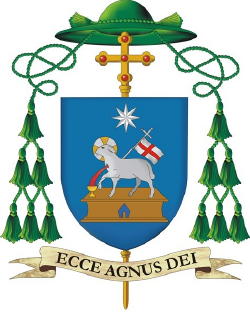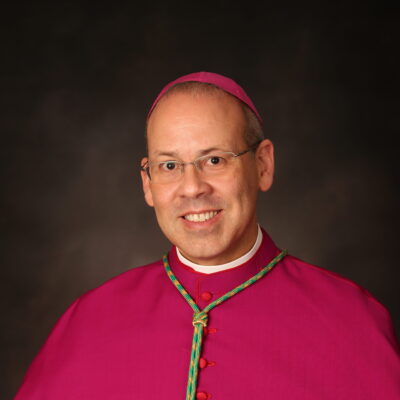The Most Reverend Juan Miguel Betancourt, SEMV
Born in Ponce, Puerto Rico, in 1970, the Bishop Betancourt is the son of Miguel and Gloria Betancourt. He is a member of the Society of the Servants of the Eucharist and Mary (Esclavos de la Eucaristia y de Maria Virgen), which he joined after graduation from college. He has served as Vicar General of the community.
Bishop Betancourt was ordained a priest on April 21, 2001. At the time of his appointment as Auxiliary Bishop of Hartford, he was serving on the faculty of The St. Paul Seminary School of Divinity in St. Paul, Minnesota, as Vice Rector of Formation, Associate Academic Dean and Assistant Professor of Sacred Scripture, and as the Pastor of the Church of St. Francis de Sales of St. Paul in St. Paul, Minnesota.
He is a graduate of the University of Puerto Rico with a Bachelor in Natural Sciences, and received a Master of Divinity degree from the Pontifical Catholic University of Puerto Rico in Ponce. Following his priestly ordination, he earned a Licentiate (S.S.L.) in Sacred Scripture from the Pontifical Biblical Institute in Rome. Fluent in English, Spanish and Italian, he has proficiency in other languages as well.
Bishop Betancourt has served on the Presbyteral Council of the Archdiocese of St. Paul and Minneapolis, and as a Board member of the National Conference for Seminarians in Hispanic Ministry. His professional experience also includes teaching at the University of St. Thomas and in the Diaconate Program for the Archdiocese of St. Paul Minneapolis, and at the major seminary, Regina Cleri and the Pontifical University in Ponce, Puerto Rico.
He was appointed by Pope Francis as Auxiliary Bishop of Hartford on September 18, 2018, and was ordained as bishop on October 18, 2018 by the Most Reverend Leonard P. Blair in the Cathedral of St. Joseph, Hartford.
Auxiliary Bishop Betancourt’s Coat of Arms
 The Coat of Arms of Bishop Juan Miguel Betancourt, SEMV, depicts the Lamb of the Book of Revelation, slaughtered but victorious, the one who is the lamp for the Church (Rev 5:6; 21:23). The victory of Christ over sin and death through his sacrifice is reflected in the rays of power around his head (Rev 5:12; 17:14). The Lamb, giving his life for his Bride, the Church, through the shedding of his blood denotes the life of love and service of an ordained minister of the Church (Rev 14:1). The Lamb of God gives his life voluntarily so his Church can live and continue her mission of salvation in the world (John 10:17-18). The Lamb rests on a plain and unadorned wooden altar, evoking a life of simplicity, a life that wants to be spent in service signaling everyone to the Lamb, Christ the Savior. Finally, the Lamb also reminds us of Bishop Betancourt’s home, Puerto Rico, whose coat of arms is the oldest still in use in the New World.
The Coat of Arms of Bishop Juan Miguel Betancourt, SEMV, depicts the Lamb of the Book of Revelation, slaughtered but victorious, the one who is the lamp for the Church (Rev 5:6; 21:23). The victory of Christ over sin and death through his sacrifice is reflected in the rays of power around his head (Rev 5:12; 17:14). The Lamb, giving his life for his Bride, the Church, through the shedding of his blood denotes the life of love and service of an ordained minister of the Church (Rev 14:1). The Lamb of God gives his life voluntarily so his Church can live and continue her mission of salvation in the world (John 10:17-18). The Lamb rests on a plain and unadorned wooden altar, evoking a life of simplicity, a life that wants to be spent in service signaling everyone to the Lamb, Christ the Savior. Finally, the Lamb also reminds us of Bishop Betancourt’s home, Puerto Rico, whose coat of arms is the oldest still in use in the New World.
The red and white banner, held by the Lamb, represents the local church of Hartford, which Bishop Betancourt has been called by the Lord to serve and give his life with joy and compassion, as well as his titular see of Curzola.
The Schoenstatt Shrine at the center of the altar represents the spirituality in which Bishop Betancourt has been formed through the charism of the Servants of the Holy Eucharist and of the Blessed Virgin Mary. The blue background is the presence of the Blessed Mother in the Church and the life of Bishop Betancourt. “Nothing without you, nothing without us” (Fr. Joseph Kentenich). “She is the great missionary, she will perform miracles” (St. Vincent Pallotti). The background also reminds Bishop Betancourt of the Church in the Archdiocese of Saint Paul and Minneapolis where he practiced his ministry of pastor, Scripture professor and formator of seminarians for more than a decade.
That strong presence of Mary is highlighted by the star. Mary, Stella Maris, reigns with her power of intercession and protection over every single member of the Body of Christ. In times of strife and distress in the Church, the Blessed Mother is the beacon of hope, promising strength, unity and security, inviting us to imitate the holiness and self-giving of her Son for the sake of his Bride. Traditionally, the eight-point star represents resurrection, salvation, super-abundance (of grace) and new beginnings.
Behind the shield is the Cross of the Apostles which refers to the call received by Bishop Betancourt to be a successor of the Apostles in ministry and authority. The five red stones on the cross signify the wounds of Christ in the words of Saint Peter, “By his wounds you have been healed” (1 Pet 2:24). The stones also denote the five constitutive dimensions of a Servant of the Holy Eucharist and of the Blessed Virgin Mary: charity, unity, joy, life of Nazareth, and love for the Church. Through these wounds and these constitutive dimensions, Bishop Betancourt wants to make known Christ’s healing love.
Bishop Betancourt has chosen as his motto “Ecce Agnus Dei,” which translates, “Behold, the Lamb of God” (John 1:29.36). Like his patron, Saint John the Baptist, Bishop Betancourt hears the call to point to and direct everyone to Christ’s heart full of love and mercy as he endeavors to configure himself more to the Lamb of God.

